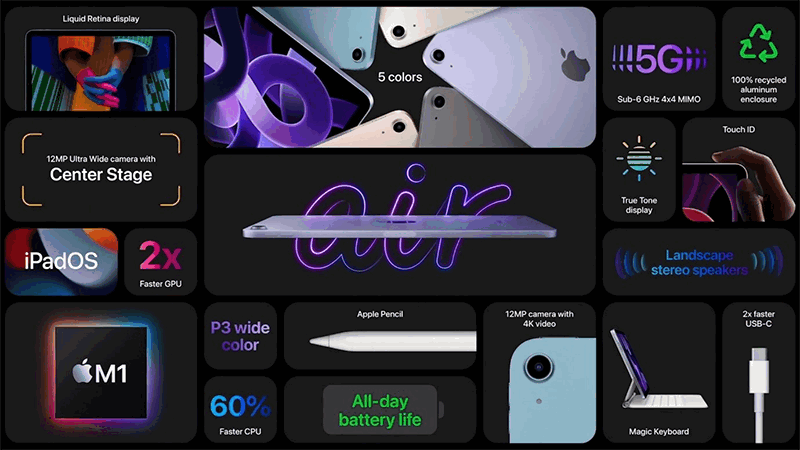When indicators stop working
12 July 2021

Among the new announcements made at the Peek Performance event, Apple introduced the fifth-generation iPad Air with upgraded features that increasingly narrow the performance gap with its iPad Pro line. This latest model seems to confuse Apple’s iPad lineup.
What’s new?
The most surprising and noteworthy feature announced for the fifth-generation iPad Air is the new M1 chip, which also powers the premium iPad Pro and MacBook lines. Apple claimed a 60% boost to CPU performance and double in the graphics department, superior to other tablets and PCs in its price range. In addition, the upgraded 16-core neural engine enhances photo capture and processing, hence better AI performance, particularly handy for creative professionals who need to perform heavy duty editing. Designing its own chips in-house was Apple’s boldest commitment to its computer and tablet businesses, showing an ethos of full integration, with hardware, software and services working best when created together. Other upgrades include a better display and camera, a USB-C port, 5G connectivity and Center Stage camera technology, most of which was already included in last year’s iPad mini.
Who’s it for?
Apple’s current tablet range includes the high-end iPad Pro (starting at US$799), the mid-range iPad Air (starting at US$599), the iPad mini (starting at US$499) and the low-end ninth-generation iPad (starting at US$329). With the current lineup, it almost seems like the iPad Air was upgraded to push consumers toward the iPad Pro. With very similar specs, asides from key features such as display, Face ID and speakers, the iPad Air is pretty much an iPad Pro killer, except that its base model storage starts at 64GB. In reality, the users who will appreciate the M1 chip are professional content creators who edit video and make 3D models on iPads. But they also need a lot of storage, so they would have to go with the 256GB option, which takes it up to US$749, almost the same price as the iPad Pro 11" base model at US$799. At the same time, the fifth-generation iPad Air also makes the iPad mini look too expensive. For an extra US$100, buyers can get Magic Keyboard support, a bigger screen and the M1 chip. So does that make the ninth-generation iPad better value than the iPad mini?
The bottom line is that it depends on what users want to do with their iPads. For most people, who are more content consumers than creators, the iPad Air with its M1 chip is probably not going to transform their lives, as the M1 is yet to live up to its full potential on iPadOS. Nevertheless, it will still be appreciated by users who want to do light creation tasks, such as typing a Word document or making a few sketches. The fifth-generation iPad Air is still a compelling device as a PC replacement, thanks to its compatibility with the Magic Keyboard and Apple Pencil.
So, what’s next?
With the new M1 chip in mid-range iPad Air models now, Apple is signaling that it has much greater ambitions for its upcoming high-end iPad Pro models, expected later this year. Apple’s launches have historically been warmly received in North America and Europe, the markets that have higher disposable incomes and a strong community of technology enthusiasts and early adopters.

Apple has long dominated the worldwide tablet market. In 2021, it topped the global market with a 39% share, a long way ahead of second-placed Samsung’s 19% share. While the worldwide tablet market shrunk by 2%, and several vendors suffered double-digit declines, Apple grew its business by 4% year on year. In 2021, Apple recorded high growth in all but the fourth quarter, when it declined by 14%, mainly due to the supply constraints that prompted the vendor to prioritize iPhones for higher margins. Canalys forecasts the global tablet market will see a corrective decline in coming years, but Apple will remain the most resilient player.